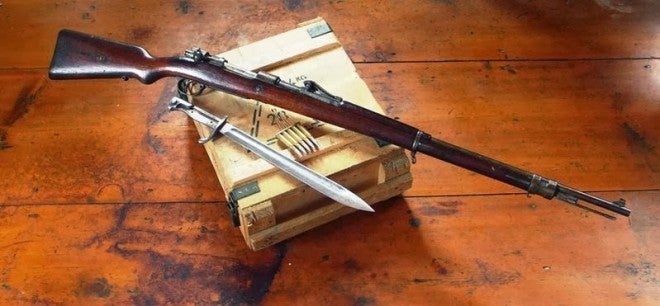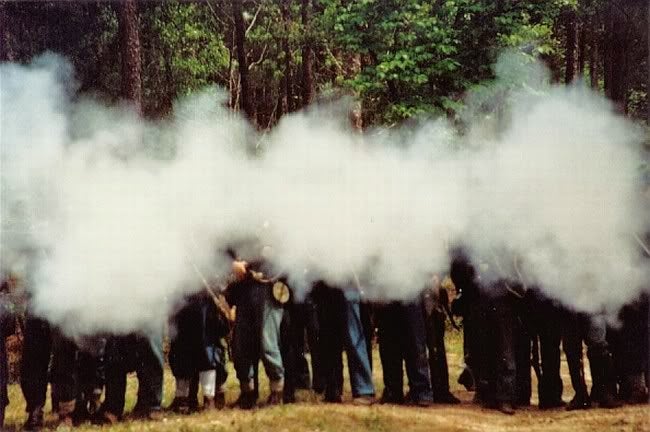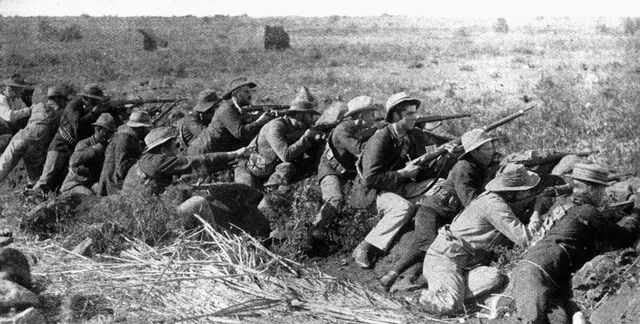This guest post is written by German milblogger Sven who blogs at Defense and Freedom.
Assault rifles typically use cartridges which are at most fine for shooting at 250 to 400 metres distant targets. This came into being based on ammunition maker (especially Rheinmetall-Borsig and GECO) experiments during the Interwar Years, and only rarely do demands for the lightweight long range unobtanium rifle flare up again.
The switch from full power rifle cartridges to shorter or smaller calibre rifle cartridges made fully automatic rifles easier to develop, lighter and more gentle in recoil. Ranges at which infantry fought its battles with its basic rifle (instead of with scoped rifles, machineguns, mortars or infantry guns) had been well within the 400 metre range most of the time ever since the First World War.
It’s common to read remarks about how infantry entered (and left) the First World War with unnecessarily heavy and long rifles. Their powerful bullets were supposed to decimate close order (quite parade-like) infantry formations at more than a kilometre distance and were also supposed to stop a horse with a single torso hit. The aforementioned remarks usually conclude that this was unnecessary, as most infantry combat of the First World War happened within 200 metres range, often even in mêlée using bayonets or shovels as weapons.
I’ve never been satisfied with this. There were long-range rifle fights during the Boer Wars with very similar technology, after all. In the meantime, I’ve become so very unsatisfied with these remarks that it’s about time to write my own take on it.
——–
The story begins in the 1880s, when inventors finally delivered practical low smoke propellants. (They are often called “smokeless powder“, but they were neither smokeless nor necessarily powders. I’m guilty of calling them “smokeless” at times, too.)
These ‘smokeless powders’ had several important consequences:
(1) Higher muzzle velocities were achievable thanks to higher gas pressures.
(2) The moderate smoke did not blind the shooter: Rapid fire became practical (unlike with the relatively impractical Mitrailleuses which are often overrated in accounts of the Franco-German War 1870/71).
(3) The weapon wasn’t fouled quickly by blackpowder residue, which again was important for practical rapid fire.
(4) The low smoke characteristic made it difficult to spot hostiles even after they opened fire. This had important consequences for the value of camouflage, for reconnaissance, for ambushes and for distance as an input for survival.
These characteristics allowed Hiram Maxim to develop his initial blackpowder-based machinegun design into the very reliable, very practical Maxim machinegun.
Rifles (and artillery) gained a lot of effective range and power as well (save for projectile weight, which was rather reducing during the move to higher muzzle velocities). Rifle marksmanship training did at times extend to formation targets beyond 1,000 metres range. Such ranges were previously achieved as well, but the technological progress made this capability much more meaningful with much flatter trajectories.
The higher muzzle velocities also allowed for lighter bullets (smaller calibres) and this in turn allowed for much more ammunition carried (though not necessarily by the individual infantryman).
By the 1890s military theorists were thoroughly impressed by the increased firepower of artillery and rifles (even though some did downplay the actual artillery ranges in their publications, apparently because published figures were lower than the secret actual ones).
The great firepower and range allowed for doctrines in which (at the latest after the marksmen-dominated First Boer War) the own infantry was expected to open effective fire at hostiles at more than a kilometer range and was supposed to establish fire superiority at more than 600 metres.
The other side of the coin was that taking such fire while orderly moving over such a distance was unacceptable, of course. The defenders did not have too much trouble with this, as they could use trees, walls and earthworks as cover and could thus reduce their exposure.
The attackers on the hand – and this was understood before the Boer Wars by some authors – had to avoid such destructive fires by exploiting concealment. They had to close to within short range without being seen, moving behind woodland, buildings, hills and obstructions. The theorists did apparently fail to appreciate that this would require the infantry to break up into quite independently manoeuvring platoons if not sections. Even as late as 1915 important authors still considered the company as the relevant unit of manoeuvre.
Now let’s assume the infantry had been equipped with short cartridge carbines and sights good for a few hundred metres only. What would have happened? Judging by individual weapons alone, the attackers could have moved on open fields up to only 400-600 metres distance again. Short cartridges and long range sights would have made things more difficult to predict, but an inferiority against full power cartridges would have been very much evident.
Infantry armament has never been homogeneous, of course. The Maxim machine gun had arrived, and it was capable of shooting well past a kilometre distance with the benefit of a proper carriage with elevation control. The water (evaporation) cooling, reliability and easier ammunition supply to just a few weapons allowed a few Maxim machinegun sections to substitute for the long range rifle firepower of an entire battalion. They were even better than the riflemen at it, as they were much fewer targets and would thus be even less exposed to long range rifle fires than the battalion’s partially covered riflemen would be.
So basically the machineguns were the better choice in the long range fire role (once available in quantity, that is by 1915). They were so good at it that the firepower of a few Maxim-pattern machineguns doomed a battalion advance over open fields from 1,000 to 400 metres distance without the assistance of rifles.
On top of this there was the light field artillery, which was also good at long-range fires, albeit not without its own difficulties.
This allowed for the individual weapons to be reduced into shorter barrel, lighter weight, shorter cartridge case, lower recoil assault rifles. These didn’t appear in service for four decades after massed rifle fires had become technically unnecessary beyond more than 400 metres.
 Your Privacy Choices
Your Privacy Choices


